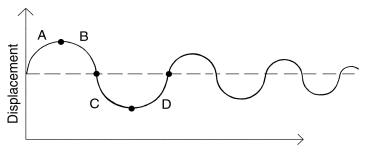Example—a guitar stringWhen a finger picks a guitar string, the entire string starts to move back and forth at a certain rate. This rate is called the frequency of the vibration. Because a single back and forth motion is called a cycle, we use a measure of frequency called cycles per second, or cps. This measure is also known as Hertz, abbreviated Hz. Often the frequency of vibration of an object is very fast, so we can also express the frequency in thousands of cycles per second, or kilohertz (abbreviated kHz)The actual distance the string moves is called its displacement. This is proportional to how hard the string is plucked. A greater displacement results in a louder sound.The segment marked “A” represents the string as it is pulled back by the pick; “B” shows it moving back towards its resting point, “C” represents the string moving through the resting point and onward to its outer limit; then “D” has it moving back towards the point of rest. This pattern repeats continuously until the friction of the molecules in the air gradually slows the string to a stop. As the string vibrates, it causes the molecules of air around it to vibrate as well. The vibrations are passed along through the air as sound waves. When the vibrations enter your ear, they make your eardrum vibrate, and you hear a sound. Likewise, if the vibrating air hits a microphone, it causes the microphone to vibrate and send out electrical signals.In order for us humans to hear the sound, the frequency of the vibration must be at least 20 Hz. The highest frequency sound we can hear is theoretically 20 kHz, but, in reality, it's probably closer to 15 or 17 kHz. Other animals, and microphones, have different hearing ranges.If the simple back-and-forth motion of the string was the only phenomenon involved in creating a sound, then all stringed instruments would probably sound much the same. We know this is not true, of course; the laws of physics are not quite so simple. In fact, the string vibrates not only at its entire length, but at one-half its length, one-third, one-fourth, one-fifth, and so on. These additional vibrations (overtones) occur at a rate faster than the rate of the original vibration (the fundamental frequency), but are usually weaker in strength. Our ear doesn't hear each frequency of vibration individually, however. If it if did, we would hear a multinote chord every time a single string were played. Rather, all these vibrations are added together to form a complex or composite sound that our ear perceives as a single tone.This composite waveform still doesn't account for the uniqueness of the sound of different instruments. For example, stringed instruments usually have a resonator. In the case of the guitar, the resonator is the big block of hollow wood to which the string is attached (the guitar body). This has a major impact on the sound we perceive when a guitar is played because it enhances or amplifies some of the vibrations produced by the string and diminishes or attenuates others. The ultimate effect of all the vibrations occurring simultaneously, being altered by the resonator, adds up to the sound we know as guitar.
Tip - Searching Documentation
Tip: To search for a specific topic, type your search query in the Search Cakewalk.com field at the top right of this page.
When the search results appear, click which product's documentation you would like to search to filter the search results further.
Note - Using Offline Help
Note: If you prefer to always use offline Help, go to Edit > Preferences > File > Advanced in your Cakewalk software and select Always Use Offline Help.
If you are not connected to the internet, your Cakewalk software will default to showing offline help until an internet connection becomes available.






